Barbara London: Today, I’m speaking with Raheleh Filsoofi. Born 1975 in Tehran, Raheleh received her BFA in studio and craft from Al-Zahra University. In 2002, she came to the U.S. and enrolled in Florida Atlantic University, Boca Raton, where she studied ceramics and received her MFA in 2014. Sound is a major part of her practice. Raheleh now lives in Nashville, where, at Vanderbilt University she is She is an assistant professor of art at Department of art and with the secondary appointment at the Blair School of Music at Vanderbilt University. Raheleh, thank you for joining me.
Raheleh Filsoofi: Thank you so much, Barbara. It’s an honor to be here. I had a chance to meet with you last year and happy to have a chance to speak to you today.
Barbara London: You once said that you were born in Iran, somewhere between the softness of Persian silk rugs and the intense colors and intricate forms of ceramic tiles. However, the reality within that space was very different. The story of your childhood is an account of growing up in a country torn in two different ways. I’m wondering, did you grow up listening to Persian music and reading Persian literature — which often is described as one of the great literatures of humanity — but also amid political turmoil?
Raheleh Filsoofi: Considering I was born just a few years before the Islamic Revolution, it was a time of curfew, and I spent many of the first years of my life at home. For the safety of the family, which included younger children, my parents tried to protect us. Then, for eight years, there was the war with Iraq. Growing up during those years, I basically explored life mostly through my ears. Not that we never had a chance to go out, but we enjoyed life in our own way. Most of that experience was listening to Iranian music, and reciting poetry, which was very common practice in my culture and within my own family.
These are the most memorable and pleasant memories that I have—lived through oral experience, as most of my generation did. It was such a pleasant experience, even while the outside world was offering something different: the sound of people marching on the street, the sound of bombing later during the war. These are the sounds that impacted my life, and I’m still sensitive to sound. Now I live with a musician. So, sound has always been an integral part of my life. It evokes memory, but it also creates new memories for me.
Barbara London: You came to North America in 1999. You have said that your early art practice in the U.S. was pretty much an exploration of your artistic heritage. Could you say something about that?
Raheleh Filsoofi: Well, I came to the United States in 2002. I left Iran and lived in Canada for a year before coming here. I came as a visitor and was an undocumented immigrant for a few years. Because I didn’t have permission to work, I had to work as a volunteer for six years and rely on support from my partner and family. When I finally received permission to work, I was interested in creating work that reflected my cultural heritage. At the start of my career, Islamic tiles with its patterns and colors that are significant to my culture were what I really wanted to explore. I started as a commercial artist and was able to support myself. It was important for me to survive through my art, and creating commercial work was the way in the beginning.
Barbara London: I’ve read about a trip you took back to Iran while you were in graduate school in 2012. You spent several months on a research trip in Iran — but this time not as an Iranian, but as an artist aspiring to learn and explore. You traveled from Tehran to villages in the north and the northwestern regions. I’m interested to know something about the women you met. I gather they opened many doors and helped you to understand and kind of reevaluate the notion of your own identity as an Iranian woman and as an artist. What did you learn that impacted your practice?
Raheleh Filsoofi: When I decided to go on the trip, I was in transition from being a commercial artist to becoming an artist focused on creating conceptual, thoughtful work that challenged me to be more sensitive to what was happening around me, especially as an Iranian living in the United States, and as an immigrant affected by years of immigration policies in this country. I went back to school to get my MFA because I thought that the academic world could open possibilities for me to change my work and also my perspective. It was a struggle. During the first year of my MFA program, I had a hard time understanding how academia worked. I was learning a new language, academic language, artistic language, and also connecting with my mentors and trying to figure out what I eventually wanted to do. One of my mentors, Dr. Brian McConnell, encouraged me to go back to Iran, just to go and see what I could discover.
We had a conversation about the women creating artwork in small Iranian villages. I had never met them, but I’d always heard about these women. Some of their products were used in my mom’s kitchen, so I had used their vessels but had never seen them at work. I went back in 2012 and did research from Tehran. During a few months of my trip, I interviewed thirty women working in the contemporary art scene of Tehran as ceramic artists, as well as artists working with clay in small villages in the north and northwest of Iran. It gave me insight into how these women work with this material in contexts very different from the modern city of Tehran, which has a lot of rules and restrictions for women practicing as artists. Going to these small villages and seeing these women freely working with their communities, and how they were impacting their own families by producing ceramic work, was really fascinating to me.
Regardless of all the crises happening in the country, these women created safe spaces for themselves to make work. They created job opportunities for their family members as well as for other people in their villages. They were also educating and training the next generation, mostly women, to be able to produce and carry that tradition forward. That’s when I felt that, as a ceramic artist, my work could have an impact in the community.
It’s not exactly about what kind of work you’re making, but about how this work goes out, engages people, and provides space and opportunity for them, not only to support themselves financially, but also to come together and collectively produce work that brings stability to their village. This had so much impact. I always say that for years I was working with clay; I’ve always been rooted in clay as a craft medium, mostly for functional or aesthetic purposes. Yet there I saw clay as a medium for the transformation of a community. I thought, “Oh, I can look at my medium in a new way.”
When I returned from that trip, my life changed. I became a social practice artist. I always say that, as artists, our inspiration often comes from very unlikely places. Some of the objects these women were producing might not be very appealing from a Western perspective. They’re humble, maybe not highly crafted, but they bring people together, people who live, work, love, and care for each other, to create that safe space, which for me was so important. I realized that’s the space I want to create within my own work. That’s what I wanted to bring from those small studios, the smell, the taste, that humble presentation of ceramic vessels, sitting in such an environment. It was very intriguing to me. Since then, I’ve been committed to bringing that simplicity and immersive experience to the viewer. That’s why I started making multimedia installations.
Barbara London: You went from making ceramics, some of which are quite large, and you moved into installation, which is a kind of social space. I think of installation as something that is not only western; artists in Japan, China, and elsewhere create installations, too.
Raheleh Filsoofi: I felt like I couldn’t just make an object, but rather a vessel. There are many social practice artists who work within the space of a vessel. Now, through my performance work, I do that, I interact with a vessel. At the time, it made sense to bring all those emotions and feelings I had from their spaces and create that within an installation environment. Now things are changing a little and shifting in my work, but that immersive experience remains, whether I’m doing installation or performance work.
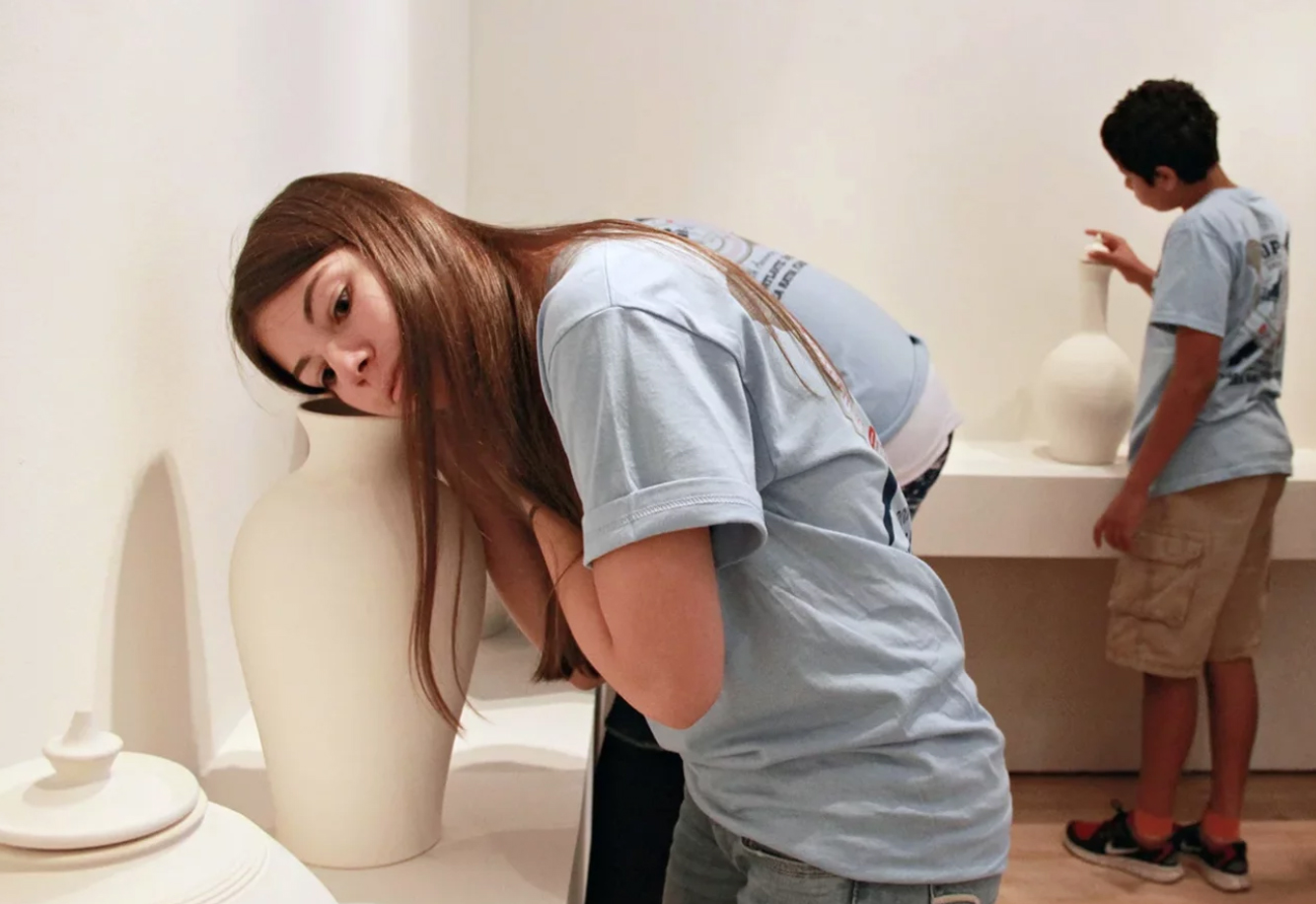
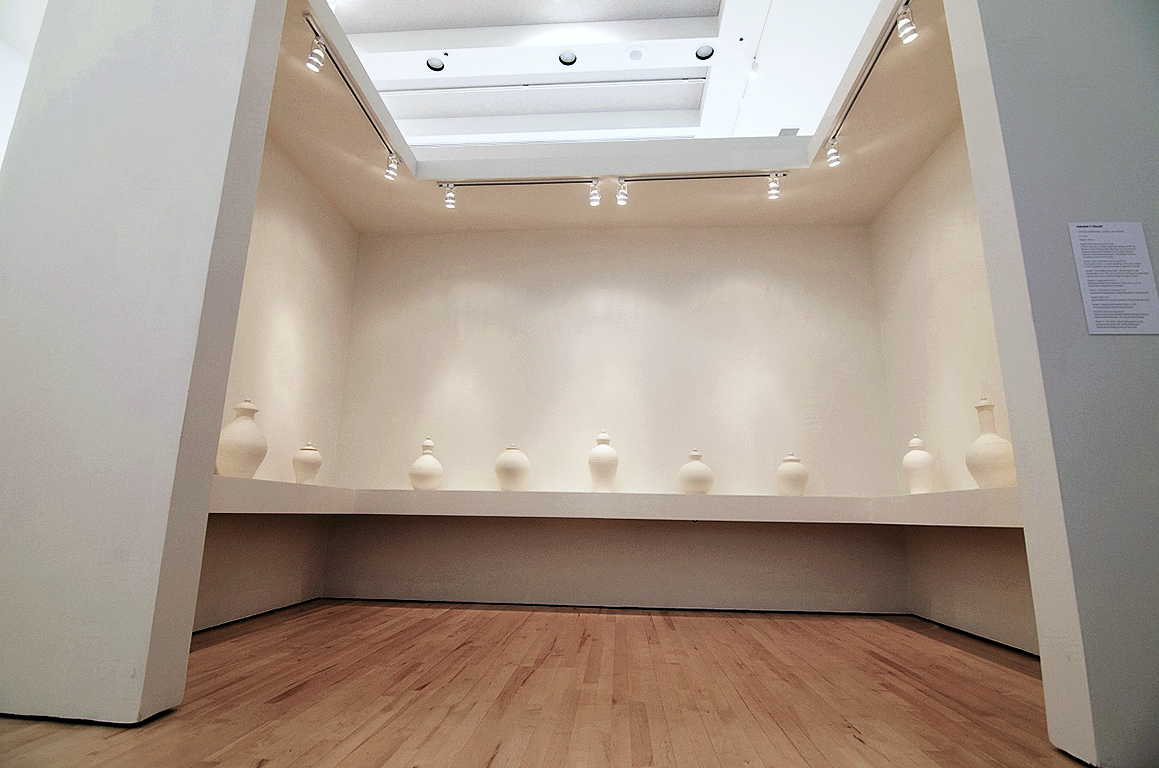
Barbara London: You made that trip to northern Iran in 2012. You made a beautiful immersive installation in 2014. The title, Only Sound Remains, is very poetic. You are exploring memory and space within the context of soundscape. For the installation, I believe you made eleven large ceramic vessels that were inspired by the tradition of your ancestors. You placed them in a room that is within a room, and are surrounded by a wall. You allowed only a small number of people to enter that space to experience the vessels and the sounds that come from them. I did not experience this work, but it seems amazing. The sounds coming out of the vessels are very lively and perhaps bizarre—from praying, to marching, an explosion, a woman telling a story, and traditional Persian music. Meanwhile, other people outside that interior area watch images of the very affecting faces two women speaking, each on a screen, with the subtle sounds of their voices.
Raheleh Filsoofi: You explained it really well, especially when it comes to space. In that installation, we have three spaces, the spaces within the ceramic vessels, the room, and then the gallery itself. When the audience enters, they hear sound, sound traveling, but they’re unable to identify the specific sounds. It was a collective of sounds moving toward the viewer as they entered the gallery. I created these spaces with attention to the audience’s actual movement, but also in reference to some historical moments from my country. I’m inspired by mosques and Islamic architecture, especially domes, how these domes sometimes hold and resonate sound, especially during prayer. In my installation, sound travels within the space, and the lids of the ceramic vessels hold sound within their interiors.
The audience, even if not entering the interior space, can still hear the sound just outside. In pre-Islamic architecture of Iran, there are sacred places people would never enter. You see this in Iranian culture, especially in houses, where there’s a space you enter before going to the main room. Homes always have this moment of entrance, which gives a pause and encourages mindfulness before entering an interior space. I created that for the audience. They hear the sounds, are evoked, but have to turn and find the entrance to go in. I try to follow this idea from architectural spaces—how sound navigates within these places to reach the outside world. I also wanted the audience to move to hear the sounds coming from a specific vessel.
I included sounds from my everyday memories growing up, both unpleasant ones and those from my favorite cartoons and my mom’s sounds. It was important for me to change the functionality of these vessels, which for centuries had served as containers for food or other things. I wanted to give the vessels a new role, a new functionality. What if they store our memories?
On the night of the opening, I thought maybe only my Iranian friends would understand. But I saw people from other cultures relate to the sounds, especially those who grew up during war and had heard those impacts. People became emotional as they listened to this collection of sounds. It’s interesting how we process sound—physically, emotionally, and spiritually.
Barbara London: The way you created the work and the way you talk about it is powerful. Did you record the sounds?
Raheleh Filsoofi: It’s the only work where I didn’t record everything myself. I tried to select sounds from different sources. I did record my mom’s voice, saving some of the messages she left on the phone. But the majority of the sounds came from searching through many historical archives, even YouTube, and from sounds that my friends sent me from Iran.

Barbara London: Let’s move on your work A Symmetrical Despondency from 2018. It is a multimedia installation with ceramic vessels, sound, poetry, and video. There are two monitors on a wall with images of your face, and flat screens with text in English and Persian, flanking two beautiful white ceramic vessels. Is it a kind of self-portrait?
Raheleh Filsoofi: Perhaps it is a self-portrait. I’ve never thought about it that way, but in some sense, it is. In one video, I’m speaking Farsi, and in the other, I’m speaking English as I recite a poem. I’m reciting a poem about three women who are experiencing the loss of a child due to war and displacement. I created that work in 2018 when I was in South Texas, where many children were being separated from their families when crossing the border. Another part tells the story of a Syrian mother who is trying to hold on to her child in the midst of chaos. These are images I’d seen or heard in the news. I’m not a mother, but I always try to place myself in the position of someone who has lost a child. I’m reciting the poems of three women who had to leave home—a place they can never return to.
I put myself in that experience of losing my own home, but I was also trying, somehow, to compare how we express our emotions through different languages. I’m reciting text in Farsi and in English. English is my second language. How am I expressing myself? I’m studying the language of expressing loss and displacement. What is the role of language? Who am I when I’m expressing myself—a witness to all these stories happening around me in the world? It was an exploration of language, how we describe and express our pain, how I see this pain, and how I reflect it. The two vessels become the witnesses and the holders of those emotions.
Barbara London: There is such a humanitarian side to your work.

Performance
Untitled Art Fair, Miami Beach, FL
December 6th, 2024
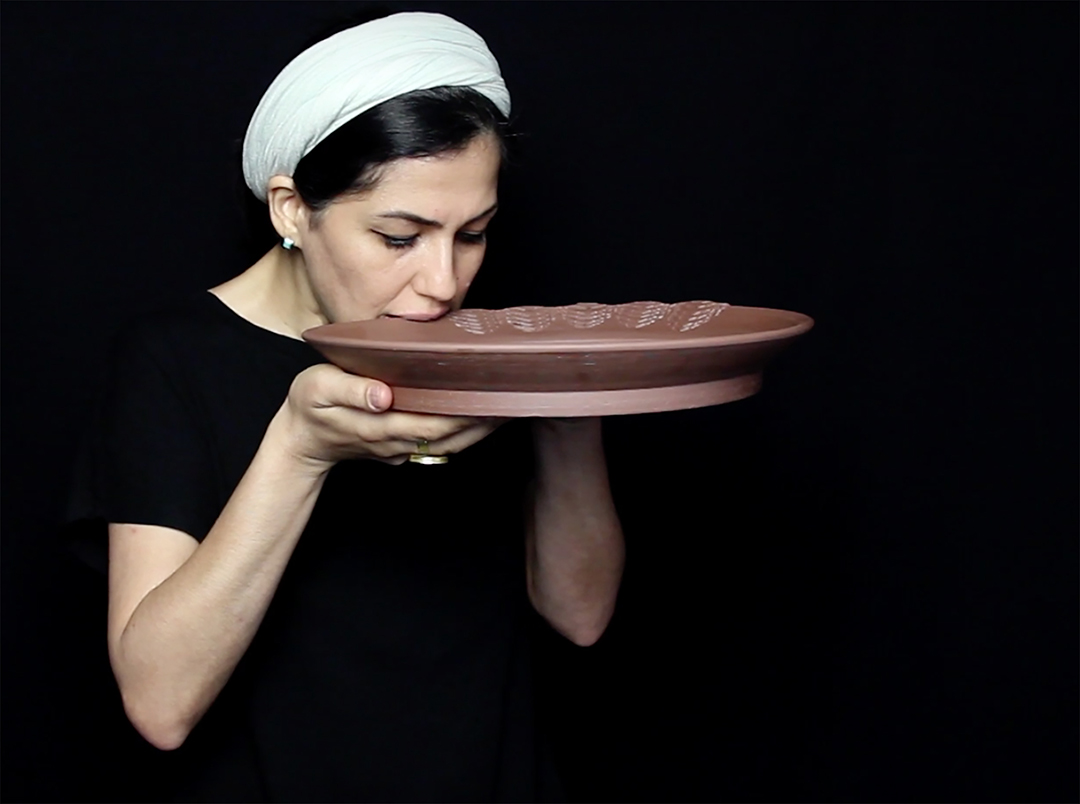

Barbara London: I want to move on to your 2022 work Bite, which is both a ceramic object and a performance. It’s a serious work, the result of a personal, artistic, and societal investigation. In the video of the performance, you are seen holding up, in a kind of honorific manner, an unglazed, unbaked ceramic plate. As you hold and slowly turn the plate, you carefully and very deliberately bite the plate’s rim and create a pattern with your teeth. It is very elegant and very spare and the toothmarks very decorative. The video is captivating, as I see that the taste in your mouth is unpleasant. The action was so visceral. As in other of your work, I believe you obtain the clay you use from local soil. Through this process, you address the concept of place and movement and sustainable use of natural resources. What am I missing here?
Raheleh Filsoofi: You explained it very well. I may just add that this work was also inspired by Islamic art and indigenous rituals, especially ones using and working with clay. Ceramic plates have always been a great platform for artists to express themselves since the golden time of Islamic art. In creating work, artists beautifully used many of the limitations that were brought by Islamic ideology, as they navigated within those restrictions. Still, they were able to create work as a great platform to embrace art, divinity, and freedom. I specifically value the ceramic plates that were made from the 9th to the 11th centuries, in Iran and in many of the Islamic regions in the Middle East. I am fascinated by how artists work in different times with the same object. Plates became an interesting object to explore.
During COVID, I was alone creating work. Most of my installations were canceled. Everybody was at home. At school I had this studio for myself. It was first time I had a facility for three months with no interruption. I hadn’t made objects for a long time. So, I started creating these plates, and that intimacy with the object was intriguing. I was also questioning what other ways of leaving marks existed. I am constantly using my hands, but what other part of my body can be used? From childhood I’ve always been sensitive to my teeth. It came to my attention that while we are separated, what remains are objects. So that relationship and that intimacy suddenly stood out to me. Objects became my friends when nobody else was around. As I was trying to negotiate this way of mark making, I tried to bite and see the mark of my teeth.
It’s such an intimate relationship. I always had thought, I’m too close to this medium, but I’d never actually felt this close. I was feeling the clay in my mouth, and it is digesting. It was very visceral. As I practice with clay, I’m also using natural resources. As I travel within the United States, I collect soil and make my clay. I know the history of the place where the particular clay comes from. I know its history and am mindful of whose resource it belongs to. I started looking at indigenous artists, how they process their clay and how ritualistic is to hold the clay itself, to make this clay and then lift it.
I felt like my body should follow that ritual, because I’m using their material, their medium. Bite started with this combination of curiosity of the historical object, the material, the history of materials, the place itself, my body. I felt that all this came to Bite. I wanted it to be easy and effortless for people to see my connection with clay, without being in any specific environment. I wanted it to be direct, about me and the clay itself, and the act of biting and leaving my mark.

Barbara London: Bite is a performance, but you end up with objects. What do you do with them?
Raheleh Filsoofi: I just bite and keep them. They’ve been on display. Somehow, I thought Bite stole so many moments from my other works. It was intriguing for the audience to experience both an object and a video. I felt like it created a shadow over some of my other works, and I loved that. I thought, “Oh, the plates deserve to be recognized.” Bite has been included in many exhibitions. But as a collection, it will be shown at Untitled during Miami Basel in the Zieher Smith Gallery booth. I just finished biting nine small plates that will be on display. The clay comes from nine different states and cities where I’ve traveled and collected soil. The soil for the earlier ones came from places where I lived or stayed for a long time in the United States.
It’s been difficult because not all the clays I’m collecting are easy to throw, and not all are easy to bite. Not all of the clay is ready for that conversation or dialogue with me. The process is so personal and intimate, and at first, I didn’t want to perform Bite in front of an audience. However, Untitled asked me to do this performance, and I said, “Okay, I will do it,” out of respect for the people representing me. I’m doing one plate every five minutes. I feel that after a few years, it will be a different experience to do it in front of an audience.
Barbara London: The plates are like your companions and are part of your life.

Courtesy of the artist and Amir Aghareb
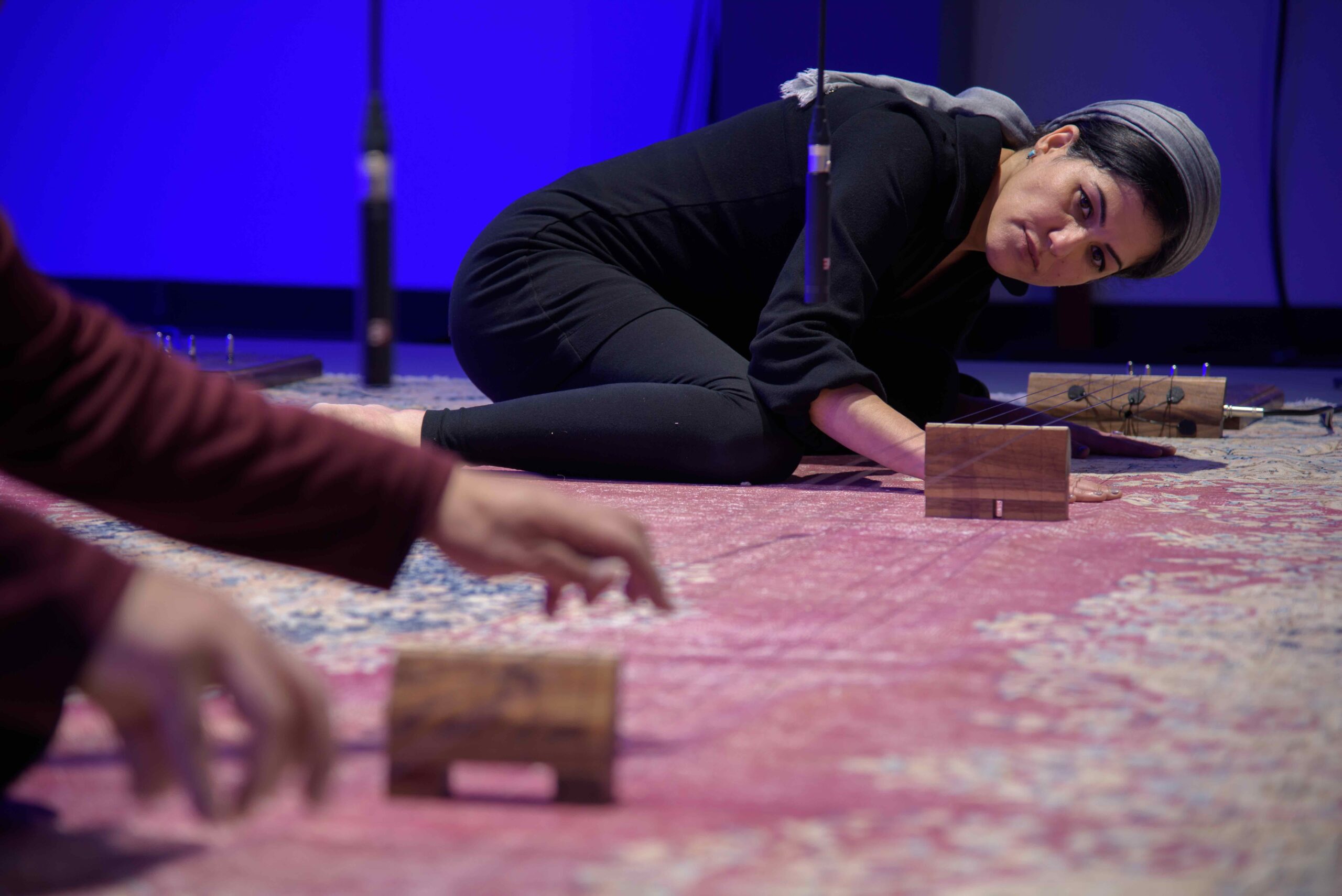
Courtesy of the artist and Amir Aghareb
Let’s move on to your music performance work. I was fortunate to experience Listening: The Fourth String, which you created in collaboration with the musician, Reza Filsoofi, who is your husband. You performed with Reza and a group of other musicians, seated on beautiful carpets at Ingram Hall, the Blair School of Art in Nashville in 2023. I believe you created some of the instruments out of your ceramics. How did the collaboration with Reza work and how did the performance work?
Raheleh Filsoofi: Reza and I have worked together on two projects. I’m not a musician. I work with sound and have been collaborating with musicians for the past eight or nine years through some of my performances and other projects. For the project you saw at the Blair School of Music, we transformed an Iranian rug into an instrument that musicians could play, but also allowed the audience and community to come, play, and make sound. We transformed the idea of what it means for an instrument to hold you. It’s very common for musicians to hold their instruments, but this time, it’s the instrument that holds you—you are within the instrument to play it. It’s a platform for the community to sit on and create sound, while musicians can witness.
For this installation and performance, we created this instrument which is an homage to the Iranian Sufi musician Moshtagh Ali Shah, who was stoned to death in the 18th century for reciting the Quran while playing music. He made significant contributions to Iranian music, and the work is a tribute to his legacy.
His work was very radical. How can we as artists also be radical—by introducing him and his legacy, by transforming a gallery into a concert hall, and a concert hall into a gallery? We asked: What if musicians become the audience and the audience becomes musicians? What if the instrument holds us? This project tried to cross many boundaries that can exist between the production of artwork, the presentation of artwork, and between artists, audiences, and community.

Courtesy of the artist
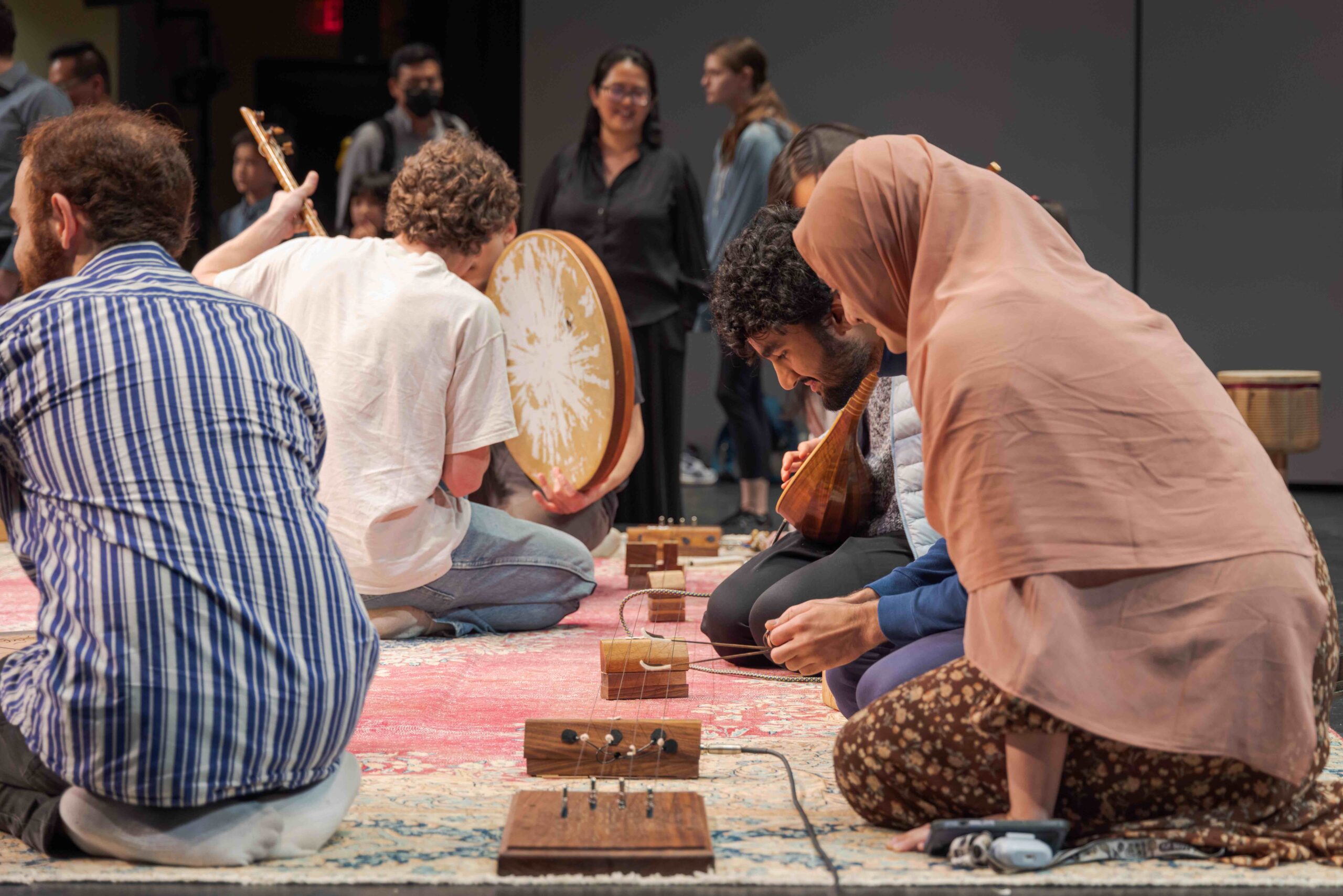
Courtesy of the artist and Amir Aghareb
The second project, The Resonance of the Land, is about creating ceramic instruments based on Middle Eastern instruments, such as darbuka and drums, which are also common in North Africa. These drums were made from clay collected in Nashville.
Nashville is known as the city of music, but primarily for one specific kind of music. However, over the past decade, especially in recent years, there has been a large influx of immigrants; Nashville is even called the new Ellis Island. But there’s no space for their music or cultural practices. So, our project aimed to bring immigrant and refugee community members in to help decorate some of the instruments through workshops, and then to perform and invite the audience to play as well. These two performances, done in collaboration with Reza, are about community and are different from my other performances, which are more intimate and personal. These are not about me; rather, they’re about creating with others, creating that safe space I witnessed among those women in the small villages in Iran. The performance became that small village, which I’m now creating in Nashville with other artists, musicians, and diverse communities.
Barbara London: That sense of community was very beautiful. The audience in the theater is a very different kind of community than the community in your gallery exhibition spaces.
We are now concluding. I know that you are a true listener, that you love to listen to good and very thoughtful music. I think sound plays an important role for you.
Raheleh Filsoofi: I love to listen, because by listening I stay quiet. As a teacher, I have to speak, especially since I get paid to speak. But listening allows me to observe more deeply, and I find that fascinating. I’ve been collecting sounds from everywhere, whenever I travel. Mostly, sound gives me a moment of peace, an awareness of place, and a chance to contemplate what’s happening around me and to be mindful of it. That’s why I’m interested in sound and music.
Barbara London: You are a collector of clay, of sound, of experience, and of people. I bet you are a very good teacher. Thank you so much. I look forward to seeing you at Untitled. I want to mention you have a wonderful website, which is full of information. I hope that our audience goes to your website. https://www.rahelehfilsoofi.com/
Raheleh Filsoofi: Thank you for talking to me and for paying attention to my work. I’m grateful to you. It’s been an honor and I’m excited to see you soon in Miami.
Barbara London Calling is produced by Ryan Leahey, with audio engineer Amar Ibrahim and production assistant Sharifa Moore. Web design by Sol Skelton and Vivian Selbo.
Support for Barbara London Calling 3.0 is generously provided by the Richard Massey Foundation and by an anonymous donor.
Special thanks to Masayoshi Fujita and Erased Tapes Music for graciously providing our music. Thanks to Independent Curators International for their help with the series. Additional thanks to Kerosene Jones and Vuk Vuković.
Be sure to like and subscribe to the podcast so you can keep up to date with new episodes in the series. Follow us on Instagram at @Barbara_London_Calling and check out barbaralondon.net for transcripts of each episode and links to the works discussed.
This conversation was recorded on November 22, 2024; it has been edited for length and clarity.